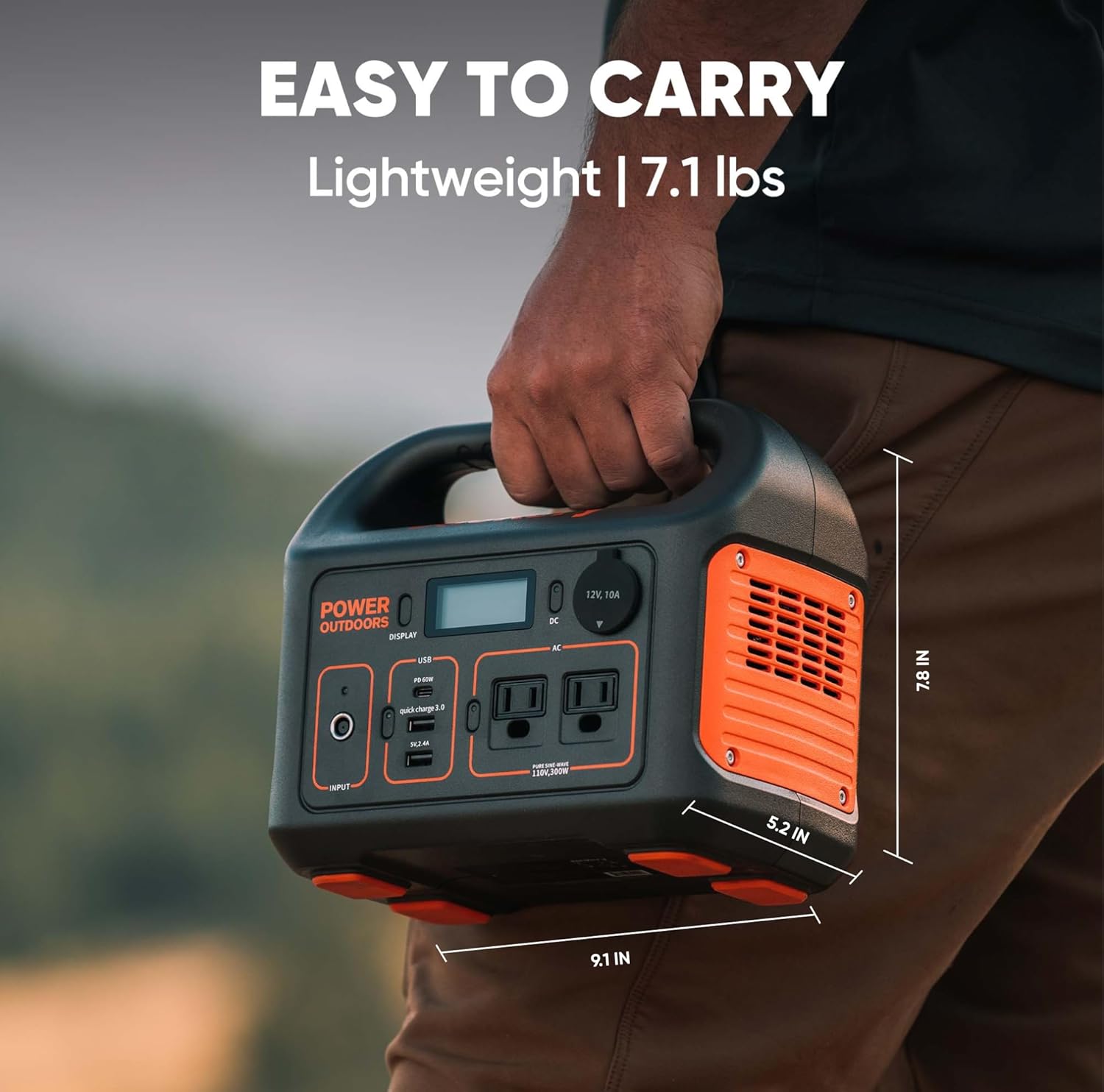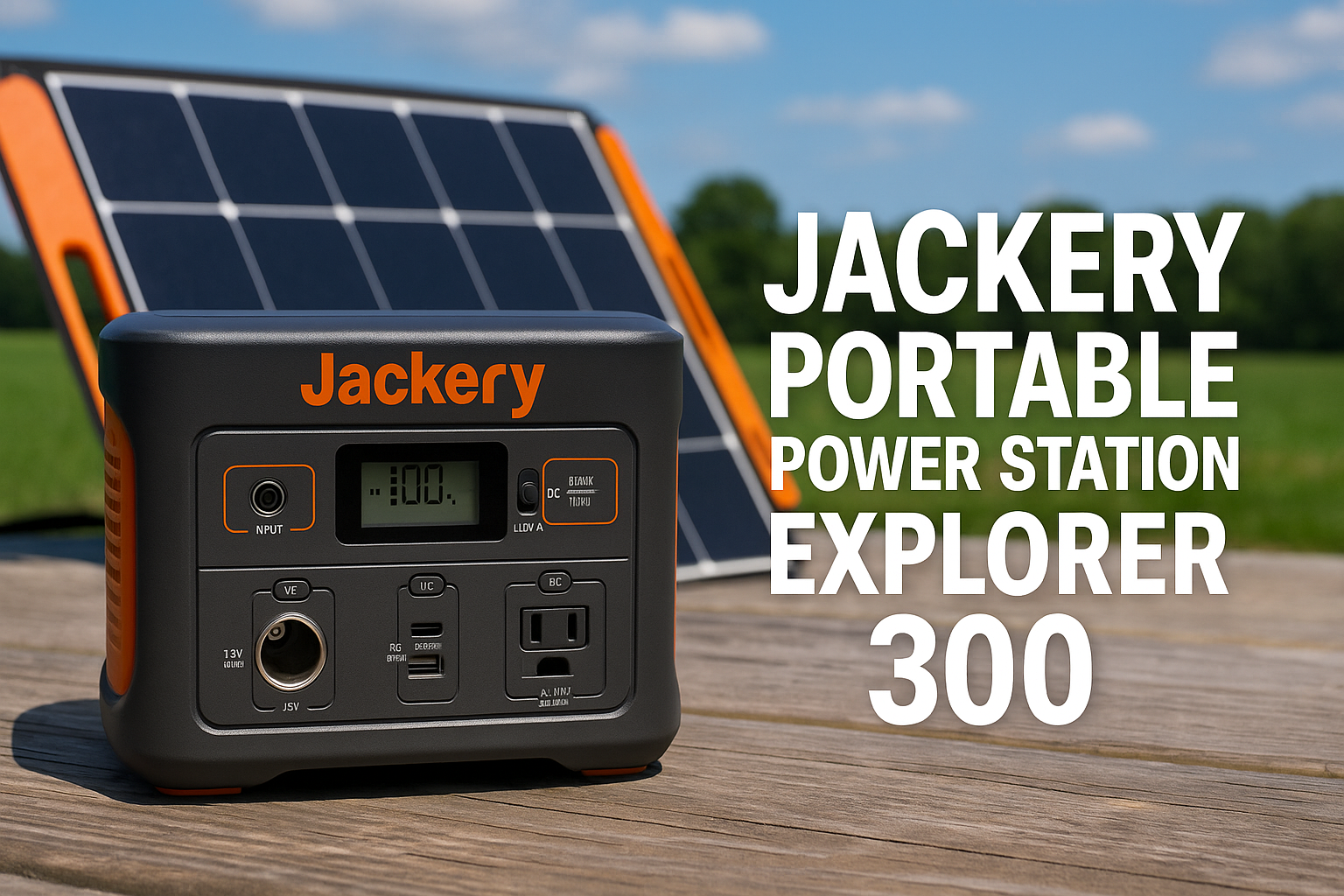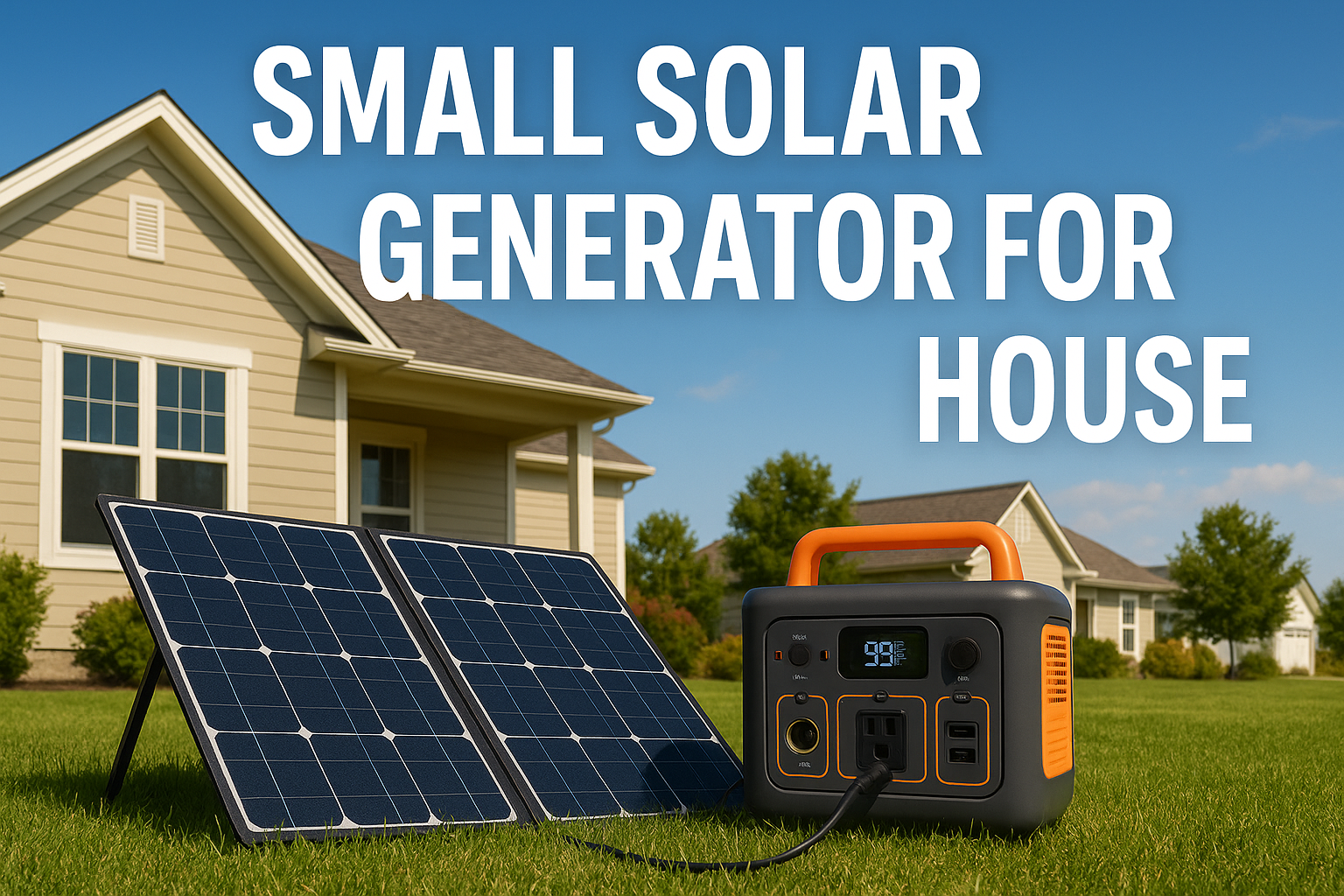Look, I get it. Shopping for portable power stations can feel like decoding alien technology. You’re scrolling through endless specs, comparing numbers that might as well be hieroglyphics, and wondering if you really need to understand what “MPPT” means. (Spoiler: I’ll explain it in plain English later.)
Here’s the deal with the Jackery Explorer 300: it’s basically a giant battery with outlets, and it might just become your new favorite outdoor companion. Let me walk you through everything you need to know, minus the confusing jargon and boring technical mumbo-jumbo.
First Impressions: What’s in the Box?
Unboxing the Explorer 300 feels a bit like Christmas morning. You get the power station itself (sporting that distinctive orange and gray look), a wall charger, a car charging cable, and a user manual that you’ll probably glance at once and then lose forever. No solar panel though – that’s sold separately, which we’ll talk about later.
The first thing that struck me? This thing is surprisingly light. At 7.1 pounds, it’s about as heavy as a small watermelon. I can easily carry it with one hand, which is a huge win when you’re already juggling camping gear, groceries, or a toddler. Trust me, future you will appreciate not needing to do bicep curls just to move your power source around.
The Basics: What Can This Thing Actually Do?
Think of the Explorer 300 as your electrical insurance policy. It stores 293 watt-hours of power (that’s enough to charge your phone roughly 24 times, give or take). But numbers only tell half the story. Let’s talk about what this means in real life.
Morning Coffee Scenario: You’re camping. Birds are chirping. You want coffee. Can the Explorer 300 run your coffee maker? Well… probably not. Most coffee makers guzzle way more than 300 watts. But can it charge your phone, power a small portable espresso maker, keep your camera batteries topped up, and run some LED lights? Absolutely.
The Power Outage Story: Your neighborhood goes dark. Everyone else is stumbling around with flashlights like it’s the Stone Age. You? You’re charging phones, running a fan, powering your wifi router, and maybe even catching up on your favorite show on a tablet. The Explorer 300 won’t run your fridge or air conditioner, but it handles the essentials like a champ.

Photo Credit: Amazon
Let’s Break Down Those Mysterious Ports
On the front of this unit, you’ll find six different ways to plug stuff in. Here’s what each one does, in human language:
The Two Regular Outlets: These are your standard wall plug holes – the same ones you use every day at home. Plug in your laptop charger, a small fan, your phone’s charging brick, whatever. These deliver “pure sine wave” power, which is a fancy way of saying your devices get the same quality electricity as they would from your wall at home. Your laptop won’t even know the difference.
The USB-C Port: This is the overachiever of the bunch. It can charge your stuff (phones, tablets, even some laptops), AND you can use it to charge the power station itself. It’s like a two-way street for electricity. Modern smartphones and tablets will fast-charge from this port, which is pretty sweet when you’re in a hurry.
The Two USB-A Ports: Remember those rectangular USB ports that have been around forever? That’s these. One is a “Quick Charge” version that speeds things up for compatible devices. The other is standard speed. Between these and the USB-C port, you can charge three USB devices simultaneously without any adapters or hubs.
The Car Port: That circular outlet that looks like your car’s cigarette lighter? That’s for 12-volt stuff – portable coolers, tire inflators, anything designed for car use. It’s surprisingly handy, even if you’re not actually in a car.
Charging This Baby Up: Your Options
Here’s where the Explorer 300 really shines. You’ve got four different ways to recharge it:
Plug It Into Your Wall: The boring but reliable method. Takes about 5 and a half hours to go from empty to full. Do this the night before your camping trip, and you’re golden.
Wall Plus USB-C Combo: This is the speed demon mode. Plug in both the wall adapter AND a USB-C charger at the same time, and you’ll hit 80% charge in just 2 hours. That’s fast enough to juice up during lunch if you forgot to charge it overnight.
Your Car’s 12V Outlet: Road tripping? Plug it in while you drive. It’s slow (6-7 hours for a full charge), but hey, you were driving anyway. Might as well arrive at your destination with a full battery.
Solar Power: Here’s where things get interesting. Pair it with Jackery’s solar panel (sold separately, unfortunately), and you’ve got yourself a renewable energy setup. It’s like having a tiny power plant that runs on sunshine. Under good sun conditions, you’re looking at about 5-6 hours for a full charge.
The Solar Thing Explained Simply
Okay, remember when I mentioned “MPPT” earlier? Here’s what you need to know: The Explorer 300 has smart technology built in that squeezes every possible electron out of solar panels, even when clouds roll by or the sun angle changes. Other cheaper systems lose efficiency when conditions aren’t perfect. This one doesn’t.
Why does this matter? Because real-world sunshine isn’t like a laboratory. Clouds happen. Shadows happen. Trees exist. The MPPT controller adapts constantly to grab maximum power regardless of these annoyances.
If you’re planning to go solar, budget around $200-300 extra for the Jackery SolarSaga 100 panel. It’s specifically designed to work with this power station, which takes the guesswork out of compatibility.
Real Talk: What Will It Actually Run?
Let me give you some practical examples from actual use:
Smartphone: About 20-25 full charges before the power station dies. That’s weeks worth of phone use.
Laptop: Depends on your laptop, but figure 3-5 full charges. Enough for a solid weekend of work in the woods.
Drone: If you’re into aerial photography, count on 4-6 drone battery charges. Perfect for a day of filming.
Camera: Photographers, rejoice. You can recharge 15-20 camera batteries. You’ll run out of memory cards before you run out of power.
String of LED Lights: Run them all night, every night, for most of a week. Great for extended camping trips.
Small Fan: Keep air moving for 10-15 hours. Summer camping just got more bearable.
CPAP Machine: Sleep apnea doesn’t take vacations. Get 1-2 nights of CPAP use, depending on your pressure settings.
Mini Fridge: Maybe 4-6 hours. Not enough for overnight, but useful for keeping drinks cold during a day event.
What It WON’T Power (And That’s Okay)
Let’s be honest about limitations. The Explorer 300 maxes out at 300 watts continuous power. Here’s what that rules out:
- Most coffee makers (sorry, caffeine addicts)
- Hair dryers (embrace the natural look)
- Space heaters (pack another blanket)
- Electric kettles (use a campfire instead)
- Air conditioners (nature’s AC works fine)
- Power tools (this isn’t a job site battery)
- Most microwaves (meal prep required)
This isn’t a weakness – it’s just physics. A unit that could power all those things would weigh 50 pounds and cost a grand. The Explorer 300 chose portability and affordability instead, which is the right call for most people.

Photo Credit: Amazon
The Screen and Buttons: Keeping It Simple
The LCD screen shows you three important things: how much battery is left (in percentage), how much power is flowing in (when charging), and how much power is flowing out (when using). That’s it. No complicated menus to navigate, no smartphone app required, no confusion.
Three buttons control everything: one for the AC outlets, one for the USB ports, and one for the DC car port. Turn on what you need, turn off what you don’t. This saves battery because you’re not powering empty ports.
One tiny annoyance: there’s a cooling fan inside that kicks on when you’re using a lot of power. It’s not terribly loud – about as noisy as a laptop fan – but it’s noticeable. If you’re trying to enjoy nature’s silence or record audio, the fan might bug you. Just plan accordingly.
Safety Stuff (Don’t Worry, It’s All Good)
Lithium batteries can be sketchy if poorly made. Jackery didn’t cheap out here. The Explorer 300 has a whole system monitoring temperature, voltage, and current flow to prevent fires, explosions, or damage. It’ll shut itself down if anything weird happens.
In regular use, you’ll never notice these protections working – they’re invisible. But they’re there, keeping you and your devices safe. Sleep easy.
How I’ve Actually Used Mine
I’ve put this power station through its paces over several months. Here are some real scenarios:
Weekend Camping Trip: Charged two phones, a tablet, a camera, and ran LED lanterns for two nights. Still had 30% battery left when I packed up. Didn’t bring a solar panel – didn’t need one.
Backyard Movie Night: Powered a small projector and Bluetooth speaker for 3 hours of outdoor cinema. The kids loved it, and I felt like a technical wizard.
Power Outage: When a storm knocked out electricity for 8 hours, I kept the wifi router running (work from home life), charged devices, and ran a fan. The fridge was fine on its own for that long.
Beach Day: Charged phones and tablets for the kids, kept music playing through a portable speaker, and still had juice for the drive-home phone calls. No car battery drain required.
Photography Trip: This is where it really proved its worth. I spent a day shooting landscapes, charging camera batteries and phone between shots, and running a small LED panel for fill light. Never worried about power once.
Comparing to the Competition
You’ve got options in this price range. The Goal Zero Yeti 200X is popular but has less capacity. The EcoFlow River 2 charges faster but costs about the same with less battery. The Bluetti EB3A has a wireless charging pad (neat!) but Jackery’s reputation for reliability tips the scales.
Bottom line: The Explorer 300 sits in a sweet spot. Enough power for real use, light enough to actually carry, priced reasonably, and made by a company with a solid track record.
The Money Question
Expect to pay somewhere between $250-$350 depending on sales. Is that a lot? Depends on your perspective. For occasional use – camping a few times a year, emergency backup, occasional outdoor events – it’s absolutely worth it. You’re paying for peace of mind and convenience.
If you need power every single day, you might outgrow this quickly and wish you’d bought bigger. But most people aren’t in that boat. Most people need power occasionally, and the Explorer 300 nails that use case.
Add another $200-300 if you want solar capability. That’s a significant jump, but it transforms this from a rechargeable battery into a renewable energy system. For extended trips or serious emergency prep, solar is worth considering.
Taking Care of Your Investment
Want this thing to last? Follow these simple rules:
Don’t store it fully charged or completely dead. Aim for around 50% for long-term storage. Charge it up every few months even if you’re not using it. Keep it in a normal room temperature environment – not in a hot attic or freezing garage.
When using it, don’t constantly run it at maximum capacity. That generates heat and wears the battery faster. And every few months, blow out the air vents with compressed air to keep dust from building up.
Do that, and you’ll get years of reliable service. Ignore it, and the battery will degrade faster than necessary.
Who Should Actually Buy This?
You’re a great candidate if:
- You camp occasionally and want device charging plus some light power
- You like being prepared for emergencies without going full prepper
- You’re into outdoor photography or videography
- You tailgate and want to power small appliances
- You have a van or RV and need supplementary power
- You work remotely and want backup for internet outages
- You’re tired of your phone dying during outdoor adventures
Look elsewhere if:
- You need to power high-wattage appliances regularly
- You’re living off-grid full-time
- You need power for multiple days without any way to recharge
- You want to expand capacity by adding more batteries later
- You need completely silent operation for recording
My Honest Take
After living with the Explorer 300 for a while, I genuinely like this thing. It’s not perfect – nothing is – but it does what it promises without drama. The build quality feels solid. The capacity hits that sweet spot between useful and portable. The multiple charging options mean I can keep it topped up whether I’m at home, on the road, or completely off-grid with solar.
The pure sine wave power means I never worry about damaging my laptop or camera gear. The display gives me just enough information without overwhelming me. And honestly, it just works. I plug stuff in, stuff charges, the power station does its job.
Could Jackery have included the solar panel in the box? Sure, but then the price would jump and many people don’t need solar anyway. Could they have made it bigger with more capacity? Yep, but then it wouldn’t be this portable. Every design involves tradeoffs, and Jackery made smart ones here.
The Final Verdict
If you’re looking for portable power in the 300-watt range, the Jackery Explorer 300 is a safe bet. It’s reliable, user-friendly, reasonably priced, and backed by a company that’s been doing this for a while. It won’t power your entire life, but it’ll handle the important stuff when you need it most.
For weekend warriors, occasional campers, emergency-preparedness folks, and anyone who values device charging on the go, this power station delivers. It’s not the cheapest option out there, but it’s far from the most expensive, and the quality justifies the price.
Would I buy it again? Yeah, I would. And I’d recommend it to friends without hesitation, which is really the ultimate test.
My Rating: 4.5 out of 5 stars
The Jackery Explorer 300 earns its place in my camping gear and emergency supplies. It’s practical, reliable, and does exactly what most people need without unnecessary complexity or excessive cost. If you’re in the market for portable power and this fits your budget, you won’t regret picking one up.
Just remember to charge it before your trip. Future you will thank present you for that simple act of preparation. Trust me on this one.




